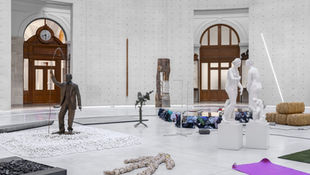
Louis Vuitton's Art-Based Approach
Louis Vuitton, a brand renowned for its craftsmanship and innovation, has developed an ever-evolving and intricate connection with the world of art over the past few decades. This partnership has transcended mere commercialism, transforming the brand’s identity into an intersection of fashion, culture, and avant-garde creativity. Through collaborations with artists, the integration of artistic aesthetics into product design, and the curation of exhibitions, Louis Vuitton has solidified itself not just as a fashion house, but as a patron of contemporary art.

Louis Vuitton’s initial connection with art was grounded in craftsmanship and the creation of luxury travel goods. Founded in the mid-19th century, Louis Vuitton began as a maker of high-quality trunks for the bourgeoisie, an essential accessory for the elite travellers of Europe. Vuitton’s pioneering approach to luggage design - particularly his flat-top trunks that could be easily stacked and his use of canvas instead of leather- set him apart in a highly competitive market. In the early days, Vuitton’s work was very much a product of the traditional European artisan ethos, which revered skill and craftsmanship. His emphasis on quality, attention to detail, and distinctive monogrammed designs helped establish a reputation for Louis Vuitton that was closely tied to the heritage of fine craftsmanship. This focus on high-quality artistry and intricate design, however, would later lay the foundation for its expanded involvement in contemporary art.
While Louis Vuitton initially built its reputation on craftsmanship and luxury, the brand’s shift towards actively incorporating art into its image can be traced back to the late 20th century. The expansion into the contemporary art world became a defining element of its strategy under the leadership of Bernard Arnault and his LVMH (Moët Hennessy Louis Vuitton) conglomerate. The idea of integrating art into fashion is not a new one, but Louis Vuitton was particularly adept at blending the two worlds. This was achieved not only through collaborations with artists but also through the way the brand approached its marketing and product design. The Louis Vuitton aesthetic, with its iconic patterns, logos, and sleek lines, is itself a form of art. The interplay between art and fashion at Louis Vuitton can be understood as a form of artistic expression that extends beyond the boundaries of clothing and accessories. In the 1990s, the brand began to establish deeper connections with the art world through collaborations with contemporary artists, setting the stage for a symbiotic relationship that continues to thrive today. These collaborations were not merely promotional or commercial but were designed to reflect the evolving cultural milieu and blur the lines between fashion, art, and design.

One of the most significant ways Louis Vuitton has fostered its relationship with art is through collaborations with renowned artists. These partnerships have not only produced unique, one-of-a-kind collections but also contributed to the cultural cachet of both the brand and the artists involved. One of the most iconic collaborations took place in 2001, when Louis Vuitton worked with the American artist Stephen Sprouse. Known for his graffiti-style art and vibrant designs, Sprouse collaborated with the brand to reimagine its classic monogrammed bags with neon graffiti prints. This collaboration marked a pivotal moment in the fashion industry, blending street culture with luxury fashion. It signalled Louis Vuitton's willingness to engage with contemporary art movements and to reinterpret its established designs through an artistic lens.
Louis Vuitton has also positioned itself as a curator of art, actively participating in the creation and presentation of art exhibitions around the world. This is most notably seen in the brand’s long-standing association with the Fondation Louis Vuitton, a cultural institution established in 2006 in Paris. The foundation, housed in a striking architectural structure designed by Frank Gehry, has become a prominent space for contemporary art exhibitions. The Fondation Louis Vuitton not only showcases the works of established artists but also nurtures the careers of emerging talents. Through its diverse and eclectic exhibitions, the foundation has become a hub for dialogue between art, architecture, and fashion. It reflects Louis Vuitton's commitment to promoting artistic endeavours beyond its products, fostering an intellectual and cultural space where art can be experienced in its purest form. Moreover, Louis Vuitton has sponsored major art events such as Art Basel and Venice Biennale, aligning itself with the global art scene and reinforcing its role as a patron of the arts. These sponsorships and exhibitions highlight the brand's ongoing commitment to the dialogue between luxury fashion and contemporary art.
Louis Vuitton’s relationship with art extends beyond commercial collaboration. The brand’s ability to position itself as a cultural authority in both fashion and art speaks to the broader cultural and economic forces at play in the global luxury market. There are several key cultural implications worth considering: Through its collaborations with artists from various disciplines, Louis Vuitton has played a role in making art more accessible to a broader audience. The brand’s ability to translate high art into consumer products such as handbags, clothing, and accessories has helped bridge the gap between the art world and the fashion industry. This democratisation of art aligns with a larger trend in the luxury market, where the boundaries between high culture and mass-market appeal are increasingly fluid.

Louis Vuitton’s relationship with art also reflects a broader trend in branding, where companies are no longer just selling products but are selling an identity and a cultural narrative. The collaboration with artists serves to reinforce Louis Vuitton’s image as an innovator, a forward-thinking brand that values creativity and intellectual engagement. In this sense, Louis Vuitton’s collaborations with artists are as much about branding as they are about artistic expression. For Louis Vuitton, art has become a means to further solidify its status as the ultimate symbol of luxury. By associating with high-profile artists, the brand reinforces its position in the upper echelons of global consumerism, where art and luxury are deeply intertwined. The exclusivity of the brand’s collaborations with artists - whether it’s limited-edition pieces or private exhibitions - ensures that the art-luxury connection remains an aspirational goal for many consumers.
The relationship between Louis Vuitton and art has evolved from a simple focus on craftsmanship to a dynamic and multifaceted engagement that continues to redefine the boundaries between fashion and contemporary culture. Through strategic collaborations with artists, the curation of art exhibitions, and its active promotion of creative endeavours, Louis Vuitton has established itself as a leading force in the convergence of luxury, fashion, and art. By merging the worlds of fashion and art, Louis Vuitton not only reinforces its brand identity as a symbol of innovation and exclusivity but also participates in a larger cultural conversation about the intersection of commerce, creativity, and intellectual engagement. In doing so, it affirms the timeless relevance of art in shaping our understanding of beauty, culture, and luxury in the modern world.





